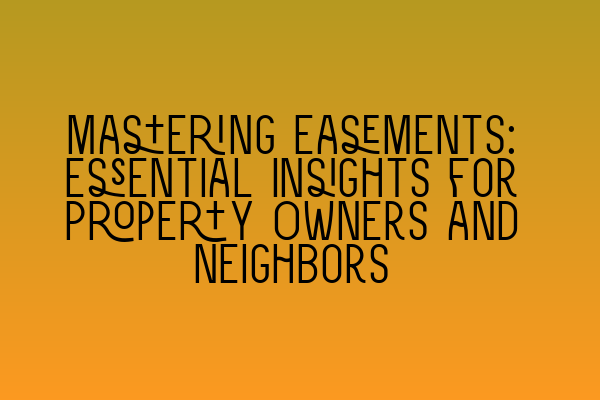Mastering Easements: Essential Insights for Property Owners and Neighbors
Welcome to the blog of SQE Property Law & Land Law! In today’s post, we will dive deep into the topic of easements and provide property owners and neighbors essential insights on how to master this complex legal concept. Whether you are a property owner seeking to understand your rights and obligations or a neighbor dealing with potential encroachments, this guide will equip you with the knowledge you need.
What is an Easement?
An easement is a legal right that allows one party to use or access another party’s land for a specific purpose. It grants a non-possessory interest in the land, meaning that the party benefiting from the easement does not own the land but has certain rights over it.
There are various types of easements, such as:
- Affirmative Easements – These easements allow a party to conduct a specific activity on another’s land, such as accessing a common driveway or laying utility lines.
- Negative Easements – Negative easements restrict the owner of the burdened land from performing certain actions that would interfere with the rights of the benefiting party, such as blocking a scenic view.
- Prescriptive Easements – Prescriptive easements are acquired through long-term, continuous, and uninterrupted use of another person’s land without permission. They can arise when someone openly and adversely uses another’s land for a statutory period (varies by jurisdiction).
Why Are Easements Important?
Easements play a crucial role in property law as they regulate the rights and obligations between neighboring landowners. Understanding easements is vital for property owners to ensure that their rights are protected and for neighbors to avoid disputes over land use and access.
When purchasing a property, it is essential to conduct due diligence and investigate any existing easements that may affect the property. Failing to do so can lead to unforeseen restrictions or obligations that can impact the property’s value and future use.
Contractual capacity is also significant when dealing with easements. Parties entering into agreements regarding easements must have the legal competence to do so.
Creating and Terminating Easements
Easements can be created through various means, such as:
- Express Grant – A property owner willingly grants an easement to another party through a written agreement or deed.
- Implied Grant – An easement is created through the actions and conduct of the parties, indicating an intention to allow shared use or access.
- Prescription – As mentioned earlier, a prescriptive easement can be acquired through long-term, continuous, and uninterrupted use without permission.
On the other hand, easements can be terminated in several ways, including:
- Mutual Agreement – The parties involved agree to terminate the easement and release their respective rights and obligations.
- Merge of Title – If the ownership of the benefited and burdened properties is consolidated under one owner, the easement ceases to exist.
- Abandonment – The benefiting party must demonstrate a clear intention to abandon the easement, typically through non-use over an extended period.
Resolving Easement Disputes
Easement disputes can arise when there is a disagreement between the parties regarding the scope of the easement, maintenance responsibilities, or attempts to terminate the easement. Resolving these disputes may require negotiation, mediation, or, in some cases, litigation.
It is highly recommended to seek legal advice from a property law solicitor when dealing with easement disputes. An experienced solicitor can provide guidance, offer alternative dispute resolution methods, and represent your interests in court, if necessary.
Conclusion
Mastering easements is essential for both property owners and neighbors to navigate the complexities of property law and avoid potential conflicts. By understanding the different types of easements, their creation and termination processes, and the available options for dispute resolution, you can protect your rights and ensure a harmonious relationship with your neighbors.
For further insights into related legal topics, please explore our SQE Contract Law Blog and consider joining our SQE Contract Law Webinars for expert guidance and analysis of recent legal reforms.
